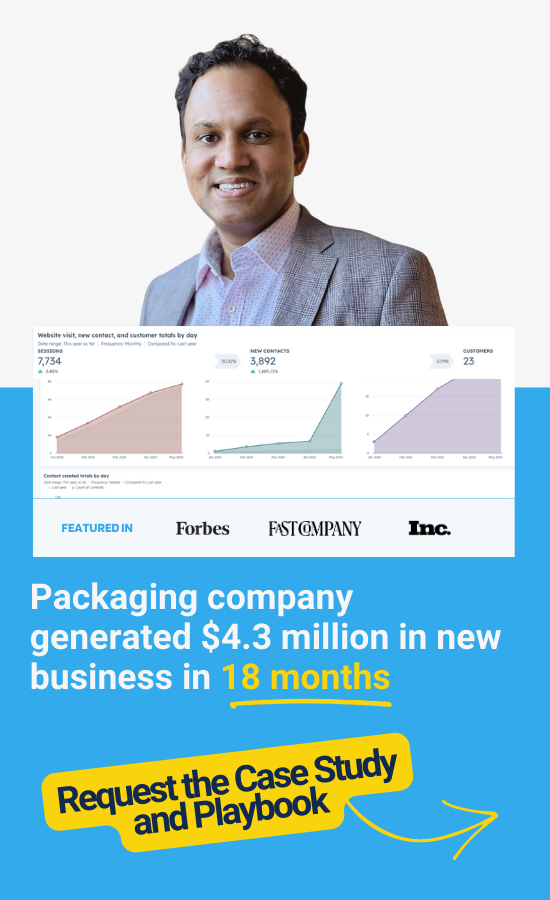Table Of Contents
Video continues to dominate the marketing landscape.
Surveys show that over 90% of marketers use video, and more than 80% of buyers have been convinced to purchase a product or service by watching a video. With high success rates and popularity across industries and audience segments, it’s no wonder that video reigns supreme.
However, anyone who has tried their hand at video marketing knows that creating original videos requires considerable time and resources—consistently planning, filming, editing, and publishing high-quality video content is much harder than it looks. Yet 89% of consumers want to see more videos from brands in 2024, so video isn’t going anywhere anytime soon.
Since good videos require so much effort, why not take full advantage of everything they have to offer?
Enter video content repurposing, a strategic approach to video marketing that ensures B2B companies make the most of their existing video assets. Today, let’s dive into the nitty gritty details of how to repurpose video content and take your video marketing strategy to the next level.
What Is Video Content Repurposing?
Repurposing content is a strategy that involves taking a piece of existing content, such as a blog post, a podcast episode, or a video, and transforming it into an entirely new format or tailoring it for a different audience.
Similarly, video content repurposing is the process of reworking an existing video to suit different channels, audiences, and formats.
Consider an example scenario: Say you have filmed an engaging video tutorial that is getting a lot of traffic on YouTube. To repurpose the video, you could chop it up into smaller segments of “hot tips” that you could then share on Instagram or LinkedIn. Those short clips will grab attention and allow your audience to interact with your brand in new ways.
The goal of video content repurposing is to reshape existing content to fit different platforms so it can reach new prospects. Think of it like recycling your best videos so they can continue to inspire your audience.
The Benefits of Video Content Repurposing
Video content repurposing is a cost-effective way to stretch your resources, extend the lifespan of video content, and cater to diverse audience preferences. Here are a few of the other benefits you can expect from repurposing video content.
Increase Reach
By using an existing video to create content in other formats, your B2B business can target channels and platforms that the original video didn’t reach. If, for example, some of your ideal customers spend most of their time online on LinkedIn, then they likely won’t find a video on your YouTube page. But if you repurpose that YouTube video into a short clip that you share on LinkedIn, you’ll reach buyers with different preferences and habits.
Maximize Audience Engagement
Audiences are looking for interactive, interesting, memorable, and helpful content. When you repurpose videos into new content formats, you give people the opportunity to engage with it in new ways, from liking and sharing social posts with the repurposed video content or attending a live Q&A session inspired by the source video.
Enhance Search Engine Optimization (SEO) Efforts
When you repurpose video content, you have the opportunity to optimize it for search engines using proven SEO techniques. Depending on the format, each new content asset could include relevant keywords, alt tags, internal links, meta descriptions, and more—all of which impact a website’s ranking on search engine results pages (SERPs). These repurposed and optimized content pieces can help improve the visibility of your website and enhance your SEO efforts.
Expand Brand Visibility
Each new video asset is a chance to reinforce your brand identity and expand your brand message across platforms, channels, and audiences. If you maintain a consistent tone, voice, and style when repurposing video content, you can build trust with your audience and establish your brand as a leader in the industry.
Strengthen Overall Content Strategy
A strong content marketing strategy requires both creativity and consistency. By reimagining existing video content for different formats and platforms, you can achieve a higher return on investment (ROI) on your content creation efforts and continue to consistently publish videos without always starting from scratch.

How to Repurpose Video Content: 6 Steps to Take
From transforming a webinar into bite-sized clips for social media or repackaging product demos into engaging tutorials, there are endless ways you can repurpose video content for new audiences, platforms, and formats. And with a little planning, you’ll be well on your way to freshening up existing content and getting more value out of every video.
Follow these steps to repurpose your B2B company’s existing video content.
1. Define What Success Looks Like & Establish Clear Goals
Everyone on your video marketing team needs to know what success looks like, so the first step is to establish clear goals, key performance indicators (KPIs), and objectives. These elements will guide every step of your content repurposing strategy.
Consider what you hope to achieve by repurposing existing video content, how content repurposing will help you achieve your marketing goals, and what KPIs you want to hit for each video repurposing project. Make sure you set SMART (specific, measurable, achievable, relevant, time-bound) goals.
2. Narrow Down Your Target Audience
Who is your target audience? What platforms do they spend the most time on? How do they prefer to consume content? Where are they in the buyer’s journey? What content formats do they like the most?
Before you start investing time and resources into repurposing existing video content, you have to learn more about your ideal customers.
Once you know the answers to these questions, you can narrow your focus to the topics, formats, channels, platforms, and messages that will resonate best with your buyers.
3. Pick Your Source Video
Look through your existing video content for videos that have performed well. Consider engagement rates, views, shares, likes, comments, and feedback. These source videos are ideal for content repurposing because they already resonate with your audience.
Evergreen content—content that stays relevant over time and provides ongoing value—is another opportunity for video content repurposing.
The right video simplifies the content repurposing process and maximizes your ability to reach and engage with new audiences on different platforms.
4. Choose the Right Platforms
Different platforms and channels cater to different audiences, demographics, content preferences, engagement behaviors, and formats. Understanding the strengths and weaknesses of each platform is a vital part of any content repurposing strategy.
The platform you choose to share your repurposed video content on should directly align with your goals, your target audience, and the content itself. For example, if one of your goals is to increase organic traffic, platforms like Twitter/X or LinkedIn are ideal because they allow direct links, which you can use to point viewers back to your content.
5. Repurpose the Video into Different Formats
After setting your goals, conducting audience research, selecting a source video, and choosing the right platform, you can start repurposing the video into new content formats.
Blog posts, social media clips, infographics, podcast episodes, ebooks, white papers, email newsletters, paid ads, GIFs—the possibilities are endless. Begin by analyzing the source video to find key points, valuable insights, and moments that can stand alone. The results of your analysis will serve as the foundation for your content repurposing efforts.
The important part is to make adjustments to the repurposed video based on the platform, like writing a captivating headline, creating platform- and industry-specific hashtags for social media, and optimizing content pieces for mobile or desktop users.
6. Monitor Progress & Analyze Results
Once your repurposed video content is up and running, it’s time to monitor your progress and analyze the results. Note what content works well with which audience segments and platforms. And track those KPIs to see how close you come to your goals.
With this information in hand, you can make data-driven decisions that will guide your future video content repurposing efforts.

9 Creative Ideas for Repurposing Video Content
Need some video content repurposing inspiration? Start with these creative ways to breathe new life into old videos.
1. Segment Videos into Shorter Clips
When it comes to repurposing video content, the first thing that comes to mind is likely segmenting videos into shorter clips. And there’s a reason this strategy is top-of-mind: It’s an extremely effective way to capture attention and convey your message.
While reviewing existing video content, look for key moments that stand out—engaging demonstrations, powerful standalone statements, helpful tips, funny moments, and more—and think about whether these clips on their own can still provide value to your audience.
Remember, even short clips on social media need a beginning, middle, and end to engage viewers and encourage them to watch the full video.
Have some segments that stand out? Remove filler content, add captions, and maintain a lively pace to create successful video clips.

2. Write Blog Posts & Articles Based on Videos
In-depth, informative, and educational videos work well when repurposed as blog posts or articles, which allow you to dive deeply into the topic at hand.
The first step is to transcribe the video, either manually or using transcription software and then reviewing the transcript to identify main themes, subtopics, points, and insights. Once you’ve rearranged the content to better fit the structure of a blog post, you can begin writing.
Don’t forget to incorporate visual or interactive elements into the blog post, and end with a strong call to action (CTA).
3. Host Live Q&A Sessions
If you have an existing video that has garnered a lot of attention, why not add an interactive element to boost audience engagement?
Schedule a live Q&A session based around the topic of the source video. Request that people submit questions ahead of time, and keep the chat open too so live viewers can also ask questions. You might want to begin the session with a recap of the original video to set the context of the Q&A, but don’t hesitate to dive right into those questions.
Additionally, after the Q&A, you can repurpose shorter clips from the session and use them as new content pieces for social media.
4. Design Animated Graphics & GIFs
A creative way to grab attention and engage your audience is through interesting animations. Repurpose video content into GIFs and animated graphics to make them interactive, shareable, and visually appealing. It’s a fun way to simplify complex ideas from an existing video and convey them in a brand new format.
What should you do with those animations? Share them on social media, embed them in an email newsletter, use them on your landing pages … the possibilities are endless.
5. Transform Webinars into Lead Magnets
Webinars are such valuable resources. After repurposing them into downloadable resources like ebooks, whitepapers, and PDFs, you can use the new content assets as lead magnets—asking potential customers to share their contact information before viewing. While the educational resources themselves help establish expertise in your industry and authority in your field, you can also capture new leads thanks to the exchange of information.

6. Turn Customer Testimonials into Video Ads
A compelling customer testimonial video not only highlights your satisfied customers but also builds trust and credibility with potential buyers. By turning these powerful testimonial videos into ads, you can hook your audience. After all, when prospects see your happy customers, they are more likely to choose your products or services.
7. Generate Teaser Trailers
Movie theaters show trailers before the movie starts for a good reason: Teasers make you want to watch the full movie when it comes out.
It’s the same thing with B2B video marketing. You can repurpose video content to promote itself by creating intriguing teaser trailers that generate curiosity, provide a sneak peek, capture attention, and encourage viewers to check out the full video.
And if you share the teaser trailers on social media, your audience can also spread the word about your brand and video content with their networks.
8. Convert Videos into Helpful FAQs
Information-rich videos are a prime candidate for FAQs. Repurpose existing informative videos into a list of frequently asked questions that you can post on your website, transform into a blog post, or share in your customer knowledge base. They are a quick and easy way to help your audience find the answers they are looking for, increasing customer satisfaction.
9. Create Audio Files & Podcast Episodes
Most videos already come with audio. Why not repurpose that audio into a B2B podcast episode?
People have different content consumption preferences, and some love audio content. (A little more than “some,” actually: Nearly 70 million people listened to podcasts in 2024.
Create an audio file or podcast episode from an existing video to make your message easier to listen to on the go. While you may want to enhance the audio or add a new introduction at the beginning of the episode, turning a video into an audio file is one of the simplest content repurposing solutions out there today.

Conclusion
Repurposing video content is a smart, cost-effective way to maximize impact, reach new audiences, reinforce your message, improve online visibility, and enhance your content strategy—all by thinking creatively about everything an existing video can become.
Looking for a video content marketing partner? We’re ready to help you repurpose existing videos, optimize your marketing process, and achieve your growth goals. Schedule a consultation with us today to get started.






